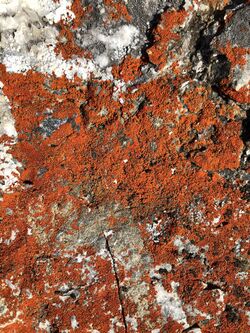Biology:Igneoplaca
| Igneoplaca | |
|---|---|

| |
| Scientific classification | |
| Domain: | Eukaryota |
| Kingdom: | Fungi |
| Division: | Ascomycota |
| Class: | Lecanoromycetes |
| Order: | Teloschistales |
| Family: | Teloschistaceae |
| Genus: | Igneoplaca S.Y.Kondr., Kärnefelt, Elix, A.Thell & Hur (2014) |
| Species: | I. ignea
|
| Binomial name | |
| Igneoplaca ignea (Arup) S.Y.Kondr., Kärnefelt, Elix, A.Thell, Jung Kim, M.H.Jeong, N.N.Yu, A.S.Kondr. & Hur (2014)
| |
| Synonyms[1] | |
| |
Igneoplaca is a genus in the subfamily Xanthorioideae of the family Teloschistaceae. It contains a single species, the crustose lichen Igneoplaca ignea.
Taxonomy
This species was first formally described in 1995 by Swedish lichenologist Ulf Arup, who included it in the genus Caloplaca. The type specimen was collected from Cape Punta Banda in Baja California, where it was found growing on rock pavement on a south-facing slope. The specific epithet ignea (meaning "fire-red") refers to the color of the lobes, which are often orange-red at the base with paler tips – somewhat resembling flames.[2] In 2013, Arup transferred the taxon to the new genus Polycauliona in a molecular phylogenetic-based reorganization of the Teloschistaceae.[3] A year later, Kondratyuk and colleagues reorganized Teloschistaceae subfamily Caloplacoideae, and circumscribed genus Igneoplaca to contain the taxon. The genus is named after its species.[4]
Description
Genus Igneoplaca is characterized by a crustose thallus, composed of red to orange lobes. Its cortical layer is paraplectenchymatous (fungal tissue with a cellular structure superficially like parenchyma of vascular plants), while its medulla is prosoplectenchymatous (fungal tissue with a structure superficially like collenchyma of vascular plants). Apothecia are lecanorine with a paraplectenchymatous true exciple. The lichen contains anthraquinones of the parietin chemosyndrome.[4]
Igneoplaca is similar to Calogaya, but that genus does not have a prosoplectenchymatous medulla.[4]
Habitat and distribution
Igneoplaca ignea occurs in Baja Mexico and in southern California. It grows on rock in sunny areas, preferentially on acidic rock such as volcanic rock, schist, pebble, shale, and granite.[4]
References
- ↑ "Synonymy: Igneoplaca ignea (Arup) S.Y. Kondr., Kärnefelt, Elix, A. Thell, Jung Kim, M.H. Jeong, N.N. Yu, A.S. Kondr. & Hur, in Kondratyuk, Kärnefelt, Thell, Elix, Kim, Jeong, Yu & Hur, Acta bot. hung.56(1-2): 164 (2014)". Species Fungorum. http://www.speciesfungorum.org/Names/SynSpecies.asp?RecordID=807568.
- ↑ Arup, U. (1995). "Eight species of Caloplaca in coastal Western North America". The Bryologist 98 (1): 92–111. doi:10.2307/3243645. https://www.researchgate.net/publication/250066648.
- ↑ Arup, Ulf; Søchting, Ulrik; Frödén, Patrik (2013). "A new taxonomy of the family Teloschistaceae". Nordic Journal of Botany 31 (1): 16–83. doi:10.1111/j.1756-1051.2013.00062.x.
- ↑ 4.0 4.1 4.2 4.3 Kondratyuk, S.; Kärnefelt, I.; Thell, A.; Elix, J.; Kim, J.; Jeong, M.-H.; Yu, N.-N.; Kondratiuk, A. et al. (2014). "A revised taxonomy for the subfamily Caloplacoideae (Teloschistaceae, Ascomycota) based on molecular phylogeny". Acta Botanica Hungarica 56 (1–2): 141–178. doi:10.1556/ABot.56.2014.1-2.12.
Wikidata ☰ {{{from}}} entry
 |

